Location
Our Washington Location
Our inpatient facility is located in Washington, and will serve Washington state. It will provide a safe & therapeutic environment for both our staff and patients.
- Edmonds
7416 212th St SW,
Edmonds, WA 98026
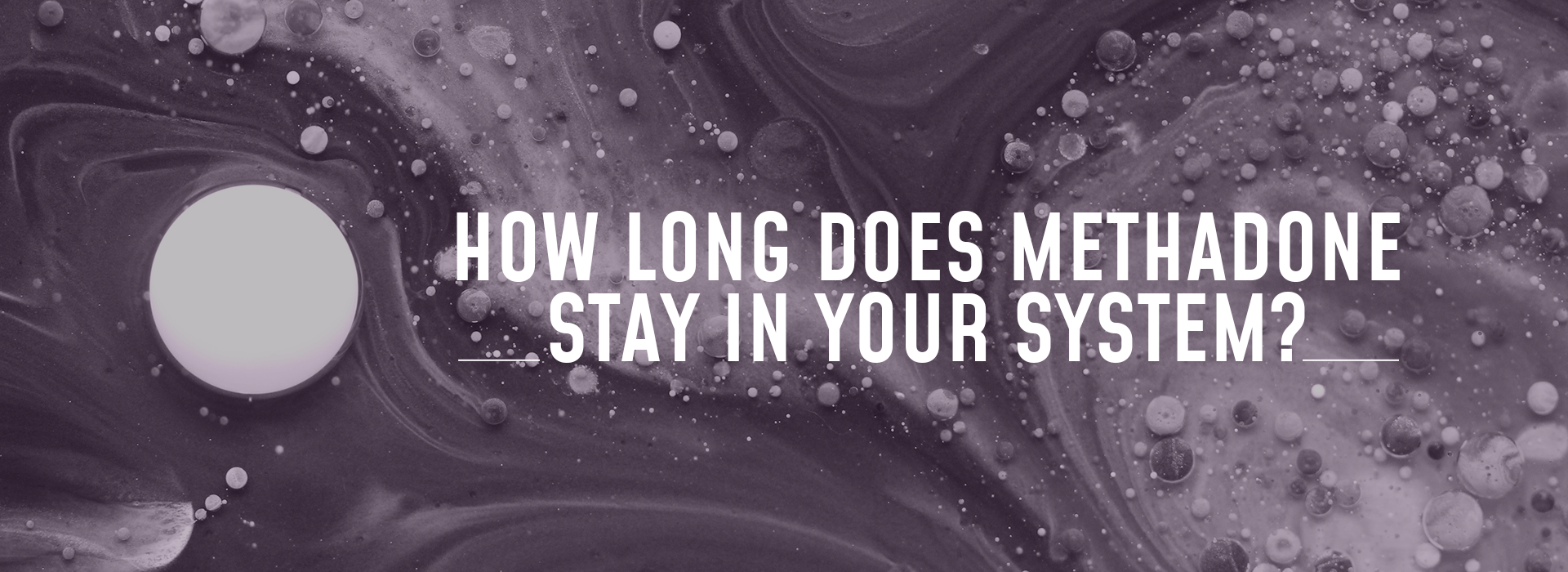
We understand that the drug is very addictive, so it makes sense for you to have these questions. We’ll do our best to answer your queries and help you get the drug out of your system for good.
For the past few decades, this drug has been used to treat people who suffer from opiate addiction. Heroin addicts and people who are addicted to prescription pills are given the drug as part of a medication-assisted treatment (MAT) program. The goal of MAT is to treat addiction by replacing heroin with another, safer substance.
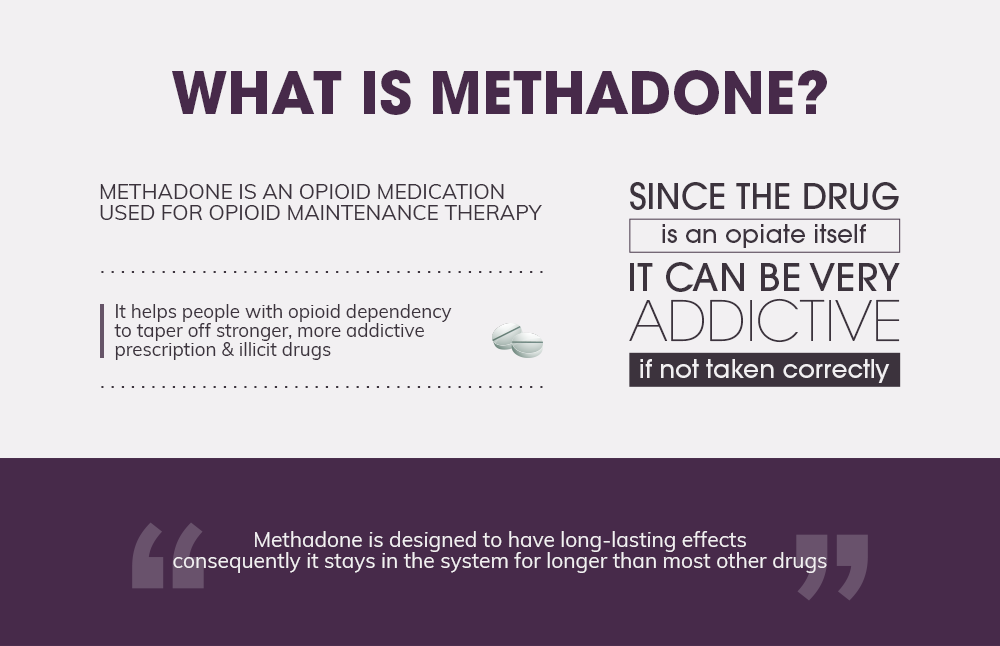
The drug, however, is also an opiate itself. Because of this, it can be very addictive in its own right.
As a substance designed to have long-lasting effects, it actually stays in your system for longer than most other drugs. It carries a high risk of addiction and can be abused easily. There is quite a lot of dispute in the addiction community around the safety and efficacy of the drug.
Methadone comes in pill, wafer and liquid forms. It is intended to be taken no more than once per day. Its effects should last anywhere between 4 and 8 hours.
It is sold under the following brand names:
When someone is abusing the drug, they may crush it up and snort it or inject it like other opiates. Doing so is extremely dangerous and should not be attempted under any circumstances.
This drug is known to cause addictions because it targets the opioid receptors in the brain. It is important, therefore, that the drug is used exactly as the doctor prescribes it. Because the drug is so addictive, many states require patients to take their dose at an outpatient treatment center. If you are using the drug for any reason, you should never take more than your prescribed dose even if you feel like it isn’t working.
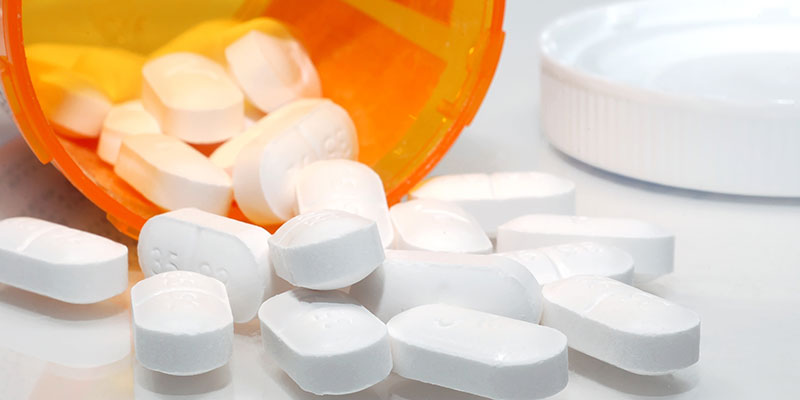
Of course, these symptoms can appear for a variety of reasons. If the individual has a history of opiate addiction and is currently not using, it is possible that they are taking a replacement drug.
People abuse this drug (and drugs in general) for a variety of different reasons. Many recovering heroin addicts take this drug because it satisfies their opioid cravings. Over time, however, the drug can be abused. Some people believe that it is not as dangerous as heroin or other prescription opiates. In turn, they might end up taking too much or using illicit means (snorting, injecting, etc) to consume it.
Other folks abuse it for recreational purposes. While there have been attempts to limit the availability of the drug, it is still available on the streets. Individuals may buy or steal it from people who carry legal prescriptions. Once you have too much in your system, you can develop an addiction to it and begin to abuse it habitually.
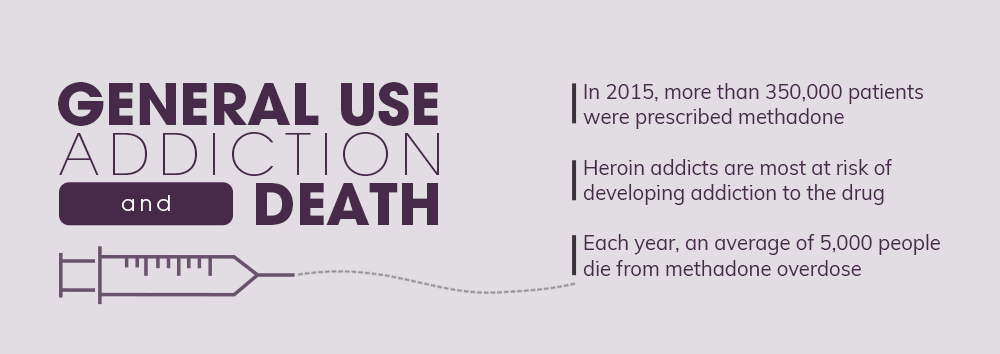


As it has been pointed out, this drug is highly addictive. Patients who take the drug (even the correct prescribed dose) can become physically dependent on it.
Aside from addiction, the drug can cause some negative long-term side effects including:
Impaired memory: Any drug that causes major disruptions in your brain on a regular basis can be damaging. If you put it in your system regularly, the drug can take a serious toll on your ability to learn and remember things.
Nerve damage: Like most opiates, this drug slows your nervous system down. If you take more than you are supposed to, it can have long-term effects on the way your nervous system operates.
Liver damage: The liver is where drugs are metabolized. Our bodies use the liver to flush chemicals out through our urine. Opiates can cause the liver to work harder than it should be. If you ingest them on a regular basis, therefore, you can do some pretty serious damage to your liver over time.
When you put too much methadone in your system, you run the risk of overdosing. You can also overdose if you use it while you have other drugs in your body at the same time. If you mix the drug with morphine, Oxycontin, Vicodin (hydrocodone), or certain other pain killers, you may experience an overdose.
In extreme cases, overdose can lead to seizures, coma, and even death. It is extremely important, therefore, that you avoid using more than your prescribed dose. It is also crucial that you avoid mixing the drug with other substances unless a doctor has granted you approval to do so.
If you think you may have too much methadone in your system, keep an eye out for the following symptoms:
If you’ve taken or are currently taking the drug, you know that the side effects of the drug last a long time. The drug’s effects will generally last up to eight hours after your last dose. Even so, that doesn’t necessarily mean that the drug is out of your system after that amount of time.
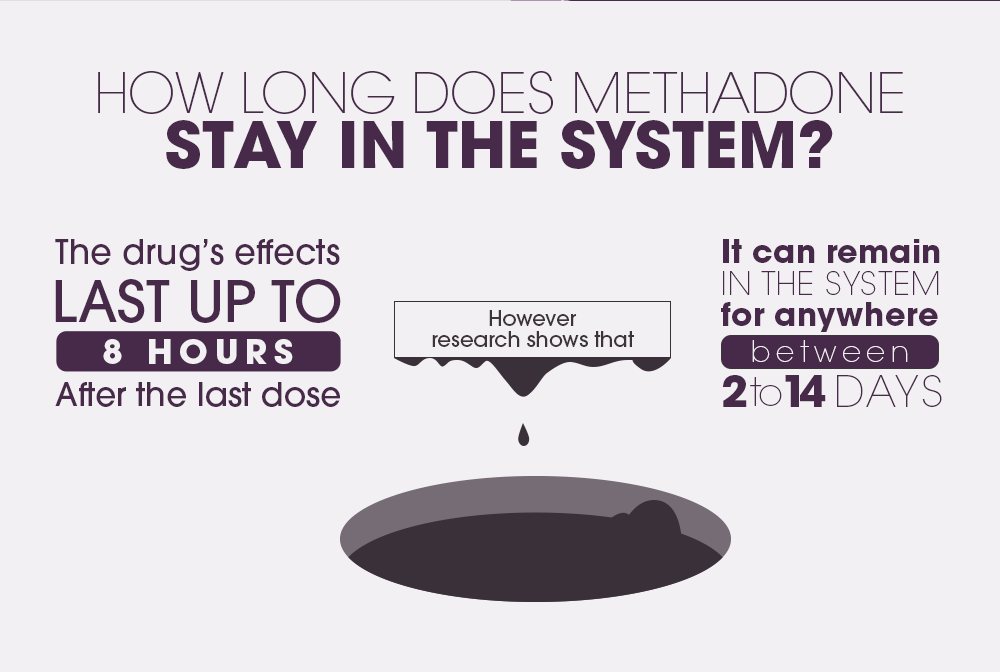
The amount of time you’ll have the drug in your system depends on who you are. Users will have varying elimination times.
Research shows that it will remain in your system for anywhere between 2 days and 14 days. The exact amount of time is dependent on a number of factors including your age, physical health, the purity of the drug and the severity of your addiction.
A drug’s half-life is the amount of time it takes for a drug to leave the body. The term “half-life” comes from the fact that it measures how long it takes for your body to break down 50% of the total quantity found in your system. While most drugs have a relatively stable half-life, the drug’s half-life can vary greatly depending on who you are.
Research has shown that the half-life of methadone can range from 8 hours to 59 hours. This means that, in some cases, it can take nearly 60 hours for someone to metabolize only half of the total quantity in their system.
We understand that it may be disappointing to learn that the drug can stay in your body for such a long period of time. However, there are a variety of factors that can impact this timeframe. If you are currently addicted to the drug, we hope that this information will help you.
Taking a urine test is probably the easiest way to detect the drug in your body. These tests are quick, relatively inexpensive, easy to take and easy to administer. Methadone can be detected on a urine test in as little as 30 minutes after the last dose.
Also, a urine test will remain positive for quite a long period of time. You can test positive on a urine test for as long as two weeks. This makes it one of the more reliable forms of drug testing.
Saliva tests are necessary for instances where a urine sample can’t be obtained. For example, police stations may use the testing method when no other method is available to them. Saliva samples offer a quick detection time, as well, increasing their popularity as a drug-testing method.
It will show up in saliva as soon as 30 minutes after the last dose. Saliva tests will test positive for as long as 3-4 days afterward.
Hair tests are used much less frequently than other methods of drug-testing. However, they can be necessary for some situations. You can test positive for methadone on a hair test for several months after your last dose.
Fortunately, it can take some time before your hair will test positive. However, frequent users will have the drug present in their hair.
If taken orally, it can be detected in your blood as early as 30 minutes afterward. Levels will peak in your blood around 4 hours after you’ve consumed it. This makes it much easier to detect using this method.
Blood tests are different for everyone. This is because of the varying elimination times that the drug carries. In most cases, however, individuals will test positive for several days after their last dose.
In very rare cases, you can get a false positive on a drug test. Taking large quantities of diphenhydramine (contained in Benadryl) can make it look like you have the drug in your system.
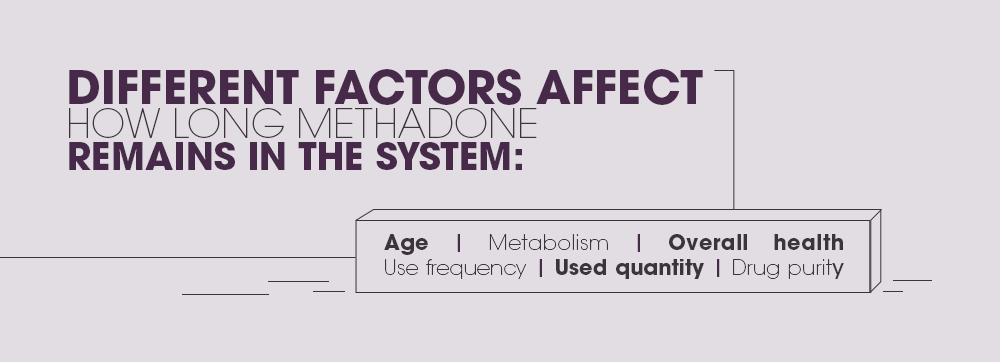
Your age: Your age can increase the amount of time it takes for your body to process the drug. This is due in part to the fact that a healthy liver eliminates the drug faster. Unfortunately, our livers often start to deteriorate as we get older.
Your BMR: The drug’s half-life is strongly impacted by your metabolism. If you have a fast BMR (Basal Metabolic Rate), you’ll be able to burn off most drugs faster than others. Folks with a low BMR have a harder time eliminating drugs from their body.
Your health: When your organs are unhealthy, it takes longer for them to eliminate drugs. Your liver, in particular, needs to be in tip-top shape in order to process drugs rapidly.
Use frequency: If you use it frequently, you’re likely to have methadone in your system for a long period of time. Your body will have to work longer and harder to process the total amount in your body which makes the total elimination time longer.
Quantities used: Taking higher amounts will make it take longer for the drug to leave the system.
Purity of the drug: Many users get their prescription from hospitals, outpatient treatment centers, and other licensed facilities. However, some other users get their fix from dealers, friends or other unlicensed individuals. These days, you never know what chemicals a batch might be cut with. If your dose is cut with a chemical that is difficult for your liver to process, it could take longer for you to get it out of your system.
Also, it's interesting to note that pregnant women tend to process it faster than non-pregnant women.
Once you are chemically dependent on a drug, you may experience withdrawal symptoms once you try to stop using it. Although it is often used to treat opioid withdrawals, this drug can also cause its own withdrawals. The drug stays present in your system for quite a long time period, which means that it can take a long time to get out of your system as well.
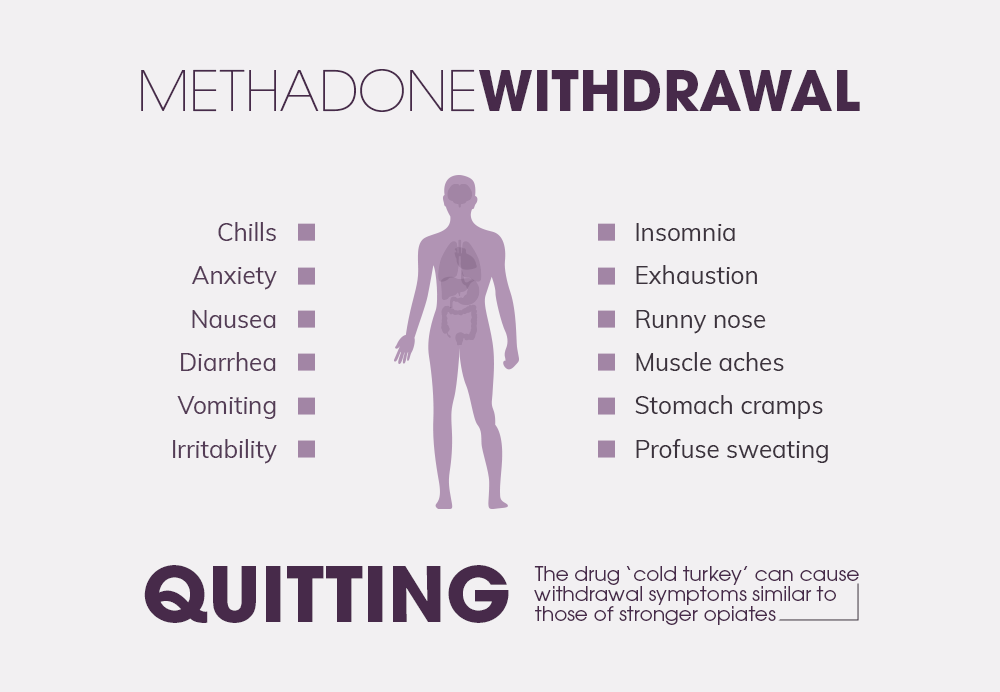
8-30 hours after last dose:> After the half-life of the drug has run its course, it will start to exit your body. Once the drug starts to exit the body, you will begin to experience early withdrawal symptoms. Sweating, chills, runny nose and exhaustion will start to appear. This phase can last between 48 and 36 hours depending on the individual.
36-96 hours after last dose:> During this period, more severe withdrawal symptoms will appear. At this point, most of the methadone in your system will have been flushed out. You may experience nausea, diarrhea or other stomach problems. It might be difficult to sleep and you may grow increasingly anxious.
96+ hours after last dose:> Withdrawal symptoms will peak after 96 hours in most cases. If you’re a habitual user and have accumulated the drug in your system, however, your withdrawals can last longer. Some users report that their withdrawal symptoms lasted for as long as 3 weeks.
It is possible that post-acute withdrawal syndrome will take effect during this time.
Many people feel better after they’ve finished going through withdrawals. However, some folks experience post-acute withdrawal syndrome (PAWS) after their detox period. This condition is characterized by a number of physical symptoms that last for several weeks after detox. It is a result of having methadone in your system for so long that your body becomes accustomed to it and doesn’t know how to respond without the drug present.
Common PAWS symptoms can include:
In severe cases, PAWS symptoms can include:
If you are going or have gone through detox and are experiencing any of the symptoms listed above, contact your doctor or addiction counselor.
It is possible to go through detox at home. While you can go through detox and withdrawals at home, we don’t recommend it. Doing so can cause the process to be more painful than it needs to be. It also comes with a number of risks.
If you detox from methadone in a professional treatment center, for example, you eliminate the risk of an overdose. Detox facilities like Northpoint Washington are drug-free campuses where you’ll have no access to the substance you’re addicted to. Because withdrawals can be painful, addicts who detox at home often relapse in order to stop their symptoms. Attending a detox program will enable you to commit to recovery.
Additionally, doctors and professional addiction specialists will be on-site to ensure that the process goes as smoothly as possible. They’ll make sure that you’re well-hydrated, well-fed and will do what they can to reduce your withdrawal symptoms. You’ll be safe and secure as you get the drug out of your system.
It can be difficult when you’re accustomed to having the drug in your system. Even if you started out with a prescription, addiction and chemical dependency can take hold fast.
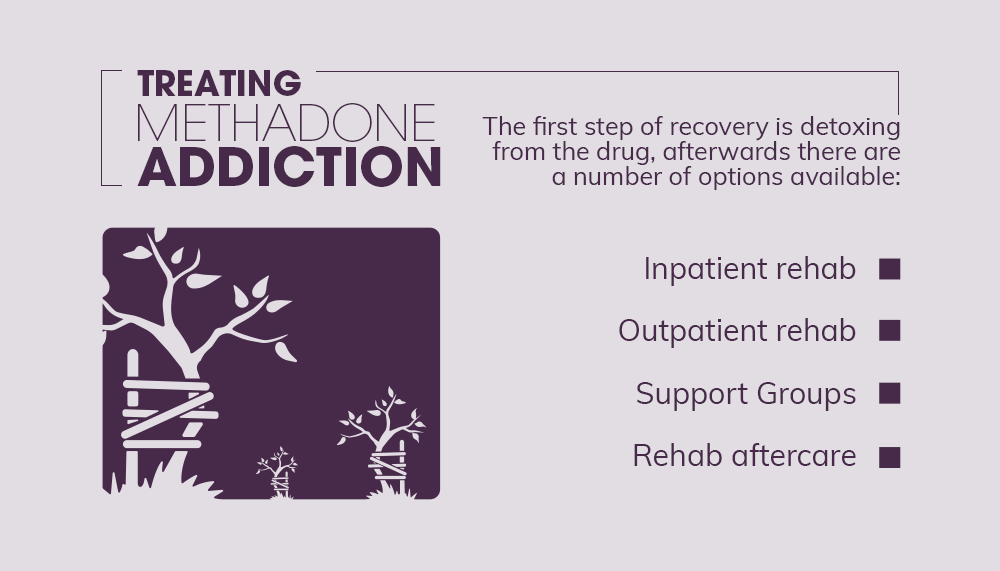
Inpatient rehab: Once you finish detoxing, you may want to attend inpatient rehab. In one of these programs, you’ll live within a drug treatment center for a few weeks. Each day, you’ll meet with addiction counselors, therapists, and other recovering addicts. You’ll talk about your experience with addiction and work toward living a life free of opiates.
Outpatient rehab: Outpatient rehab is similar to inpatient but you don’t live in the treatment center. Many addicts, after all, lack the time and resources necessary to attend an inpatient program. In an outpatient program, you will receive the same level of support and therapy as inpatient attendees but will be allowed to leave once you’ve completed your daily meetings.
Narcotics Anonymous (NA): Narcotics Anonymous is a fantastic resource for methadone addicts. NA is an organization that holds free addiction support meetings for people who struggle with drug problems. At each of these meetings, addicts gather to discuss their experience with addiction and lend support to one another as they all work to stay clean.
Rehab aftercare: There are a number of post-rehab treatment options for addicts. After you’ve completed detox and rehab, for example, you may want to live in a halfway house or residential treatment center. This will help you to keep drugs out of your system as you work to stay drug-free after you get clean.
Many addicts avoid detox and rehab because they think it will cost too much. In reality, however, there are plenty of affordable treatment options, even for people who don’t have much money.
Most insurance providers will cover at least some of the costs associated with detox and rehab. This enables you to get rid of the methadone in your system, go through treatment and start the recovery process without having to empty your bank account.
Additionally, rehab facilities like Northpoint usually offer payment plans that enable you to pay for treatment over time. It is our belief that no one should go without treatment simply because they lack the funds.
If you’d like to discuss our payment plans or verify whether your insurance plan covers rehab costs, please contact us today. We want to help you get on the road to recovery as soon as possible.

If you struggle with addiction, getting the right kind of treatment is essential to your recovery. You may need to go through a period of detox first. Most people find that this is quite helpful for them. Once you detoxify, you can attend a rehab program to work on staying clean.
Professional addiction treatment can help you tremendously. Recovery is something you should never attempt on your own.
We’d love to help you as you consider your next step to addiction recovery. Do you have any questions about your drug habit or how long drugs stay in your system? Contact us today to get help and answers

Our admissions coordinators are here to help you get started with treatment the right way. They'll verify your health insurance, help set up travel arrangements, and make sure your transition into treatment is smooth and hassle-free.
888.450.2153Contact Us